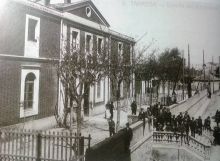TÀRREGA
Name of the station: Tàrrega Station.
Date of inauguration: 30th May, 1860.
Author: Adrià Lomas
Origin and evolution
Tàrrega station (km 226.8 on the Zaragoza-Lleida-Manresa-Barcelona line) is located in the very centre of the town. Train services first arrived in Tàrrega in 1860, when the corresponding stretch of what was then the Manresa to Lleida line came into service.
This formed part of a project promoted by major business interests, such as the Girona family from Barcelona. However, it was not until the beginning of the 20th century that its commercial activity became fully developed. Having a direct connection with Barcelona and being an access point for the Pyrenees were key factors that helped make Tàrrega station a significant point of reference (figure 1). For a number of years, the town was a centre of distribution for agricultural and food products in Western Catalonia, with cereals being the most important product transported by the railway, together with the heavy materials produced by the industrial company Trepat. In fact, moves were even made to establish Tàrrega as the focal point for a new line between Balaguer and Igualada.
Figure 1: The station in the 1910s

Source: Photographic Archive of the Local District of L’Urgell. AHCT
From the 1950s onwards, road travel gained ground with respect to rail in terms of the transportation of both goods and passengers. Even so, Tàrrega station offered good intermodality between trains and motor vehicles. By the end of the 1970s, however, the decline of rail travel resulted in a reduction in the number of services reaching the town.
At present (figure 2) the line is only used for passenger transport, with 10 trains per day: 6 services in the direction of Lleida and four towards Barcelona.
Figure 2: The current station
Source: ADIF
Special features
The great commercial activity associated with the production of goods led the town of Tàrrega to establish its own Official Chamber of Commerce and Industry (1905) and to open what was, at the time, only the third branch office of the Caixa de Pensions savings bank (1910).
On 15th October 1927, the arrival of the Orfeó Català, an influential Catalan cultural association, caused great expectation (figure 3). At that time, the local population realised the possibilities that rail travel offered in terms of passenger mobility.
Figure 3: Great expectation was caused by the arrival of the Orfeo Català in Tàrrega, in 1927
Source: Lluís Sarret. Private collection of Francesc Robinat
1985 saw the celebration of the 125th anniversary of the Manresa-Lleida line. This was commemorated with a visit from an old steam locomotive, which stopped at the town.
In 1992, a special train was put on to cover the demand for passenger services during the town’s Festival of Street Theatre.
Environment
Figure 4 shows the municipal map of Tàrrega in 1925, with the urban area limited by the river to the south and the railway to the north.
Figure 4: Map of Tàrrega, 1925
Figure 5 shows images from the Catalan Institute of Cartography; it is possible to see the urban nucleus of Tàrrega, with the railway station occupying a central position. This aerial image, which was taken from a plane in 1956, allows us to see how the railway acted as an effective barrier to the growth of the town. This obstacle has since been largely eliminated and the track now forms part of the urban continuum towards the north.
At the beginning of the 20th century, the railway station’s activity was mainly associated with the transportation of goods; in 1910, there was an uncovered loading bay and a crane. Many local companies were then engaged in freight logistics because the station was an important strategic point between Barcelona and the Pyrenees. Near the station, there used to be four inns to cater for the needs of travellers and there were also travel services from the station to the spa of Vallfogona de Riucorb. In the 1930’s, Carrer Segle XX – a street next to the station – contained a number of very significant buildings which were a direct product of the dynamism generated by the railway station. At that time, there was also a branch line that ran as far as the wheat storage warehouses of the Balcells flour mill.
The years immediately after the Spanish Civil War were an important time for freight transportation (figure 6), but the town’s commercial activity subsequently declined in the latter decades of the 20th century. Today, the railway services are exclusively for passengers. This situation has given rise to protests about the deterioration of the line and its station and particularly the lack of carriages on train services.
Figure 6: Rail freight transport in Tàrrega in the 1930s
Source: Salvador Albareda Flaquer. Photographic Archive of the Local District Museum of L’Urgell. AHCT
Figure 7 shows how activities near the railway station have changed between 1912 (upper image) and the present day (lower image). In the past, there were a number of services for travellers (coaches and inns) that are no longer available.
Figure 7:
Source: www.fotosdecatalunya.cat
Nowadays, the services associated with the railway station are in a clearly evident state of deterioration, but in their heyday, they represented a significant advance for the town. The railway station itself now only offers public access to its ground floor and the ticket service is only operative for a few hours in the morning.
Figure 8 shows the present map of the city.
Figure 8: Map of the town of Tàrrega
